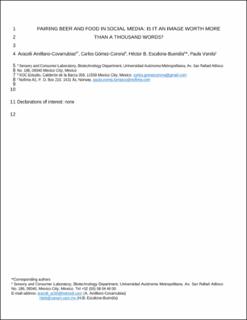| dc.description.abstract | Food pairing has been widely studied to understand the patterns that explain how people pair different foods and ingredients and, therefore, to obtain successful pairings and good recommendations for consumers. Social media has become a common way of exchanging information; therefore, we proposed to use it as a tool for exploring beer-food pairing and eating behavior. Twitter and Instagram were selected as they are among the most popular platforms. Although texts from Twitter could provide an accurate verbal description of consumer's food experiences, Instagram could offer the possibility of exploring the consumption context through images, leading to a better understanding of consumers' eating behavior, with a focus on food and beverage combinations. We hypothesize that images from Instagram will provide further information than texts from Twitter, regarding beer-food pairing and consumption context. A social media study was performed in Mexico comparing texts vs. images, selected from a one-year period, and manually classified through content analysis. Foods extracted from images and texts were categorized into frequencies and analyzed using multiple correspondence analysis (MCA) and hierarchical clustering (AHC). MCA showed the most frequently mentioned foods paired with beer for each platform. Data extracted from images and texts about consumption context was also analyzed and categorized into frequencies according to several themes: consumption behavior, type of consumption, way of beer consumption, place of consumption, and consumption occasion. Data extracted from the two platforms was compared by using a chi-square test per theme. Several differences were found, depending on the social media platform, texts being the one with less extracted and meaningful information. In general, while texts provided less extracted and meaningful information, images offered more details regarding beer-food pairing and context of consumption, the same as beer information such as type, color, brand, and style. Overall, images gave more information on beer-food pairing compared to texts. The methods and results from this paper could be applied by culinary professionals, sommeliers, and researchers in the gastronomy and food and hospitality areas. | |
